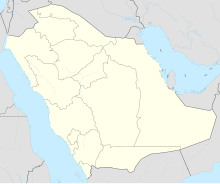Dosariyah
Dosariyah , also Dawsariyyah or Dosarije , Arabic دوسرية, DMG Dausariyya , is an archaeological site in the Saudi Arabian province of Ash-Sharqiyya , which dates back to the late 6th and early 5th millennium BC. Dated to the Arab Neolithic . The first Obed pottery finds in Saudi Arabia come from Dosariyah .
location
The site is located about 12 km south of al-Jubail in a dune area, about 800 m from the coast of the Persian Gulf . Today Dosariyah appears as a roughly north-south oriented, 2 m high hill. A hill in the east blocks the direct view of the Persian Gulf. The Sabcha as-Summ plain extends south of the site . The surrounding landscape is characterized by sand dunes and sparse vegetation.
Research history
Dosariyah was discovered by Grace Burkholder in 1968. Scattered over a wide area, she found large amounts of painted and unpainted ceramic shards , stone tools made of flint and obsidian , conch shells , bones of mammals and fish, and plaster of paris on the surface of the site . In the same year, Geoffrey Bibby classified the ceramics as Obed-temporal and, based on this discovery, recommended a further investigation of the site. In the course of the first excavations in 1972, Abdullah H. Masry in Dosariyah was able to prove a sequence of at least seven settlement horizons to a depth of 2.50 m, which were stratigraphically separated by stratigraphically poor layers . Following these investigations, a massive fence was erected to protect the site. Since 2010, new excavations have been carried out by a Saudi-German team from the Dammam Regional Museum and the University of Tübingen .
Research situation
The range of finds and stratigraphic observations during the excavations date the main phase of settlement in Dosariyah to the Arab Neolithic or the Obed period of southern Mesopotamia. This dating is confirmed by the direct dating of mussel shells, which the site dates back to the late 6th and early 5th millennium BC. To date. Apart from a shard from the Islamic period from the surface, there is little evidence of a later settlement. With the exception of a few recent remains on the surface, the site is undisturbed. In addition, the conservation conditions for organic material are extremely good. Because of these favorable conditions, Dosariyah is particularly suitable for exploring the Neolithic on the Arabian Peninsula.
Pottery and function of the settlement
The range of finds in Dosariyah shows elements of the local Arab Neolithic as well as influences from South Mesopotamia . In particular, large quantities of Obed ceramics, which were imported from South Mesopotamia, indicate extensive cultural contacts. About 25% of the ceramics from Dosariyah are characterized by very coarse aging . This "coarse ware" is considered to be locally produced. Obed pottery can be found in a variety of Neolithic sites on the south coast of the Persian Gulf. However, while only a few pottery shards were found at many of these sites, large quantities of imported obed pottery, but also finds of obsidian, point to the importance of Dosariyah within an extensive social and economic network. Individual archaeological horizons up to more than 50 cm thick, which for the most part consist of the shells of pearl oyster shells of the species Pinctada radiata , can give an indication of pearl fishing. Whether it is a permanently inhabited settlement at Dosariyah or a station periodically used by pastoral nomads for trade, fishing, etc., is the subject of the current investigations at the site.
literature
- Geoffrey Bibby : Looking for Dilmun. Knopf, New York 1969, ISBN 0-3944-3400-5
- Geoffrey Bibby: Preliminary survey in East Arabia 1968. Gyldendal, Copenhagen 1973, ISBN 87-00-91091-0
- Grace Burkholder: Ubaid Sites and Pottery in Saudi Arabia. In: Archeology 25 (4), s. 264-269, 1972
- Robert Carter & Harriet Crawford: Maritime Interactions in the Arabian Neolithic. The Evidence from H3, As-Sabiyah, an Ubaid-related site in Kuwait. Brill, Leiden 2010, ISBN 978-90-04-16359-1
- Philipp Drechsler: Places of contact, spheres of interaction. The Ubaid phenomenon in the central Gulf area as seen from a first season of reinvestigations at Dosariyah (Dawsāriyyah), Eastern Province, Saudi Arabia. In: Proceedings of the Seminar for Arabian Studies 41. 2011
- Philipp Drechsler: Palaeolithic - Neolithic: natural and cultural area. In: Roads of Arabia - Archaeological Treasures from Saudi Arabia. [Exhibition catalog]. Ed .: Museum for Islamic Art - State Museums in Berlin. Berlin 2011, ISBN 978-3-88609-721-0 , pp. 59-65.
- Abdullah Hassan Masry: Prehistory in northeastern Arabia. The Problem of Interregional Interaction. Kegan Paul International, London and New York 1997, ISBN 0-7103-0536-2
- LJ Oates, D. Kamilli, H. McKerrel: Seafaring Merchants of Ur? In: Antiquity 51 p. 221-234, 1977
- M. Roaf, J. Galbraith: Pottery and p-values: 'Seafaring merchants of Ur?' re-examined. In: Antiquity 68 (261), s. 770-783, 1994

